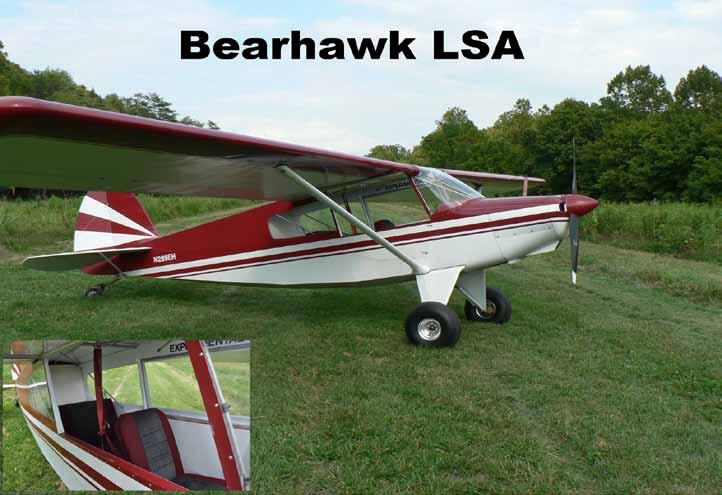
3 minute read
BEARHAWK LSA
some static friction in the elevator that I considered slightly excessive for a pushrod system. Cockpit control motion felt normal, with no interference with legs, seats, panel, or other typical motion limiters.
Engine controls consist of throttles on the left panels, mixture and carb heat push-pull controls on the left of the instrument panel, and a magneto switch on the right. The P-leads and spark plug leads are the only electrical wires in the prototype, however, a full electrical system is available as an option to builders.
Advertisement
Fuel sight gauges are placed at the right and left wingroot locations, and the fuel switch is a right/left/both/off switch on the center front cockpit floor. The instrument panel is completed by an airspeed indicator, a non-precise altimeter (I love it), a wet compass, oil pressure/ temperature indicator, and a tachometer.
There are large flop-up windows on both sides of the cockpit, and the one on the right is matched with a hinge-forward door for cockpit entry.
All in all, this was my kind of cockpit. Glass was minimal, and what was there was round, with a maximum of 3.25-inch diameter, no buttons to push, just simply stuff required to fly the airplane, and no more. Not much excuse for heads-down flying in this airplane.
Let’s Fly
For the first flight, Barrows conducted the hand-powered start, while I watched from the back (with no brakes). The taxi-out on the paved taxiway appeared effortless, and the ride was very smooth on the 21-inch tires. Runup consisted of a mag check and a very short takeoff checklist: final check of fuel valve position, takeoff trim set, and visual traffic check.
The Takeoff: Brace Yourself
My RVs give a pretty good push from the back of the seat on takeoff; I didn’t expect much from a fixed-pitch, 105 hp LSA.
(continued from page 31)
Wrong. I’d intended to take a peek over Barrows’ shoulder at the lift-off speed, but the rapid 200-foot takeoff roll, followed by a steep 60 mph IAS climbout precluded a peek at much of anything. I would estimate the initial climb was in excess of 1000 fpm. I thought LSAs were supposed to be sissy airplanes.
The Climb: More of the Same
Barrows set up the climb at 2600 rpm and full throttle (still not 100 percent power; the fixed pitch prop thing) and 80 mph IAS. At this point, he gave me control of the airplane. I varied the speed between 60 and 80 mph IAS and began to make test inputs. From the rear, visibility was good out the sides and below, but S-turns were required for forward visibility, due to rather steep climb attitude, even at 80 mph IAS.
Pitch trim was quite adequate, but not oversensitive. Control harmony was well balanced; neither pitch nor roll forces dominated maneuvering tasks. The pitch friction I felt on the ground was not noticeable in flight. A quick check of longitudinal static and dynamic stability indicated good, positive stability.
Cruise Flight: How fast can it go on 80 hp?
Leveling at 5000 feet MSL, where the outside air temperature was zero degrees F, the throttle was set at 2600 rpm, which produced an estimated 65 percent power (68 hp), burning approximately six GPH of fuel. The estimated 65 percent figure was later changed to 76 percent (80 hp) as a very conservative estimate for comparison with other LSA designs.
GPS groundspeed into the wind was 95 knots, downwind was 107 knots, for an average (no wind) groundspeed, and true airspeed of 101 knots (117 mph). During the speed checks, Barrows was showing an IAS of 115 mph. I later calculated the CAS as 110 mph, so at this speed, the aircraft ASI was indicating about five mph high. Looking back, I wish I’d calibrated the ASI at near stall speed, because it was
impressively low.
Cruise Stability
Pitch trim was positive with comfortable sensitivity. Control harmony was well balanced with forces slightly higher than climb values. There was no noticeable friction in any axis. Pitch velocity and acceleration gradients were positive and the presence of a phugoid further verified positive pitch static stability. The shortperiod frequency was moderately high, which indicated a strong level of pitch static stability.
The directional axis was strongly stable, with a well-damped Dutch roll at moderate frequency and high roll-to-yaw ratio. Rudder inputs showed a high level of dihedral effect. The roll axis had a high level of roll damping and a neutral spiral mode.
Aileron inputs resulted in significant adverse yaw, about the level expected for aircraft of this configuration. The adverse yaw could be well controlled with coordinated rudder and aileron inputs. Attitude, heading, altitude, and airspeed were easily controlled, and rudder compensation was required for aileron inputs.
The bottom line? The Bearhawk LSA is quite stable in cruise flight. Once you get the airplane in the desired attitude it’ll stay there. Just don’t expect to keep your feet on the floor during maneuvering.
Slow Flight and Stalls
Still at 5,000 feet. I slowed the baby Bearhawk to 50 mph IAS and went through the same stability checks as at cruise. Stability was still good in all axes, frequencies a little lower, controls a little softer but still quite stable, and well ahead of an aft limit. Adverse yaw was slightly more pronounced, but still quite controllable.
The aircraft stalled at 28 to 30 mph IAS








